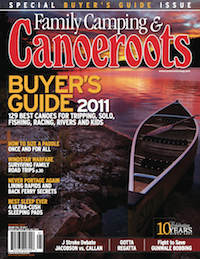Whether you’re passing time on a rest day or scrounging for your next meal, fishing for lake trout is a fun activity on any canoe trip. The small, deep, remote lakes paddlers love are also home to some great wilderness fishing. Thirty-year veteran guide Gary Skrzek shares his canoe fishing methods.
Trolling in a Canoe
Begin with the bow person sitting facing backwards. While the stern person paddles, the bow person drops a line to the desired depth. Next, the bow person puts the fishing rod down and paddles backwards while the stern person drops a second line. Once both lines are at the desired depth only the stern person needs to paddle. Keep the canoe moving or the two lines will get tangled with one another or snagged on the bottom.
Some tips for successful trolling from a canoe:
- Move the canoe just fast enough for the lure to work. Any faster and it will be hard to keep your lure at the proper depth.
- On most reels, reeling backwards 50 cycles lets out around 53 feet of line. When fishing for summer lake trout, you want to stay in the 40- to 55-foot range.
- Try to troll along drop-offs or around shoals and islands that are next to deep holes.
- When a trout bites your lure, you need to set the hook hard.
- Trout like small lures. Expect to catch 20-pounders on lures smaller than your thumb.
Tackle
The traditional method of trolling for lake trout uses steel wire and thick heavy rods, but these are best replaced with thin line and a light action rod for two reasons. First, this setup is much easier to bring on remote wilderness canoe trips. Second, it can be difficult to sense depth with steel wire so snags are common. When a snag can’t be freed, the line must be cut at the canoe leaving a 200-foot coil of steel wire in the lake. All too often loons, fish and mammals get caught in this tangled mess.
What You Need
All you need to catch lake trout from your canoe is a light action fishing rod, six-pound-test fishing line, a three-way swivel, a two-ounce weight and a lightweight trout spoon.
Building a three-way swivel rig:
- Tie two lines to a three-way swivel, one about 20 inches long and the second 23 inches
- Tie you sinker your to sinker to the 23-inch line. Feedin lake trout will stay in the 40- to 55-foot range during the summer so a two-ounce weight is adequate. The sinker line is a little longer so your lure stays off the bottom if you get a snag
- Tie your lure to the shorter line. Small, feather-light sppons that are silver or silber mixed with blue, green or pink work best

This article first appeared in the Spring 2011 issue of Canoeroots Magazine.




